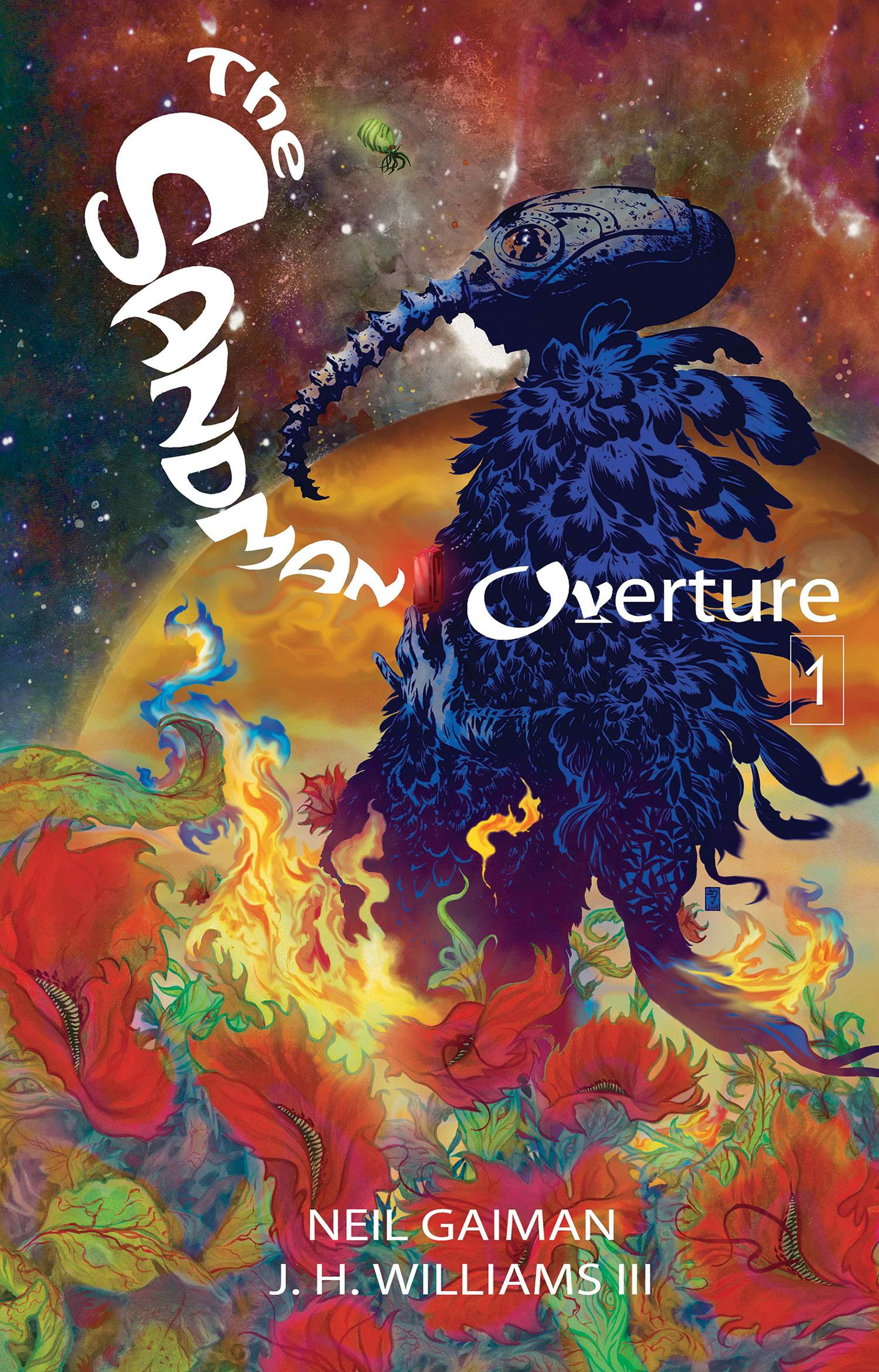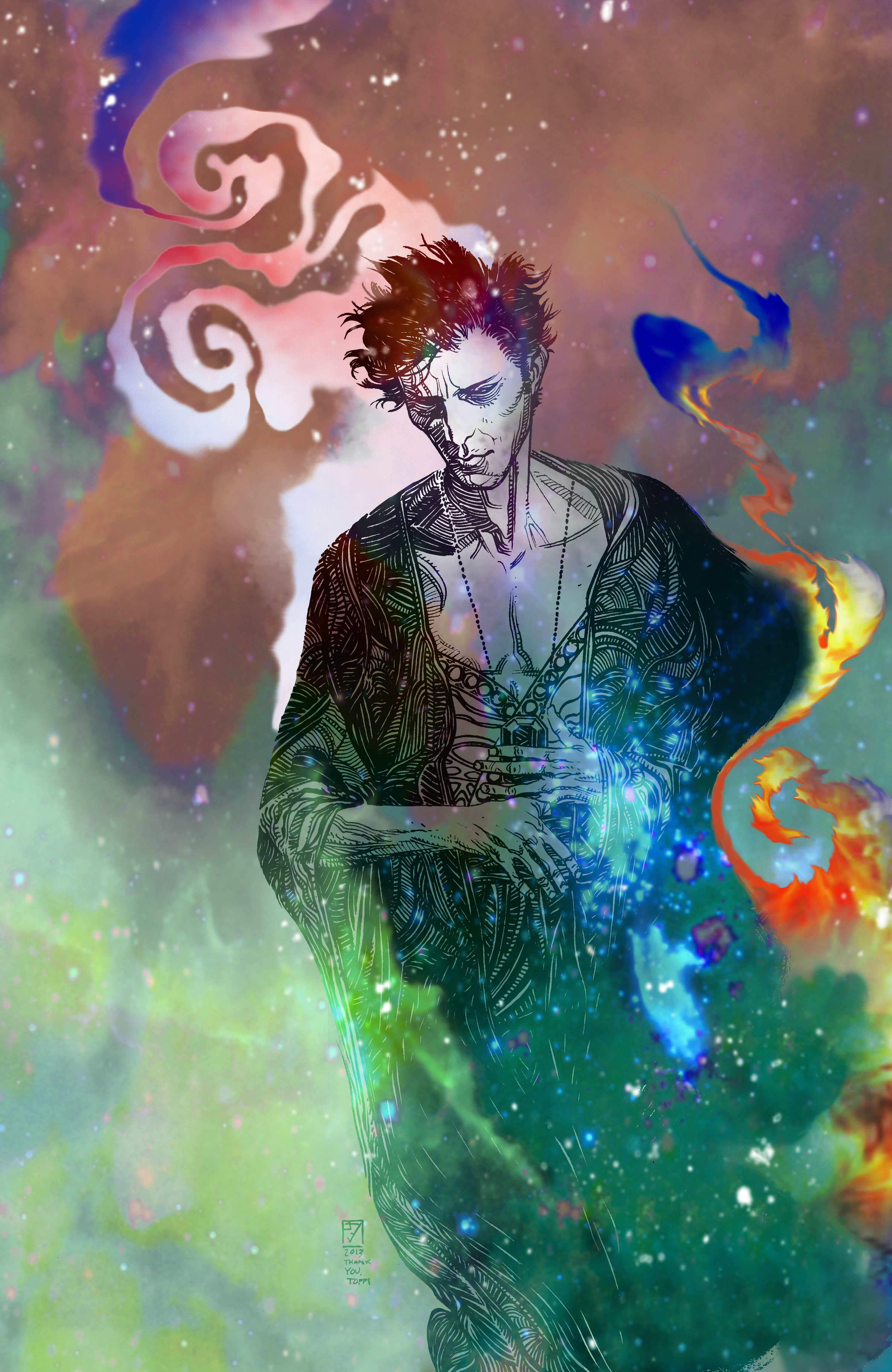In December 1988, a lonely handful of people made their way to Staten Island to the very first signing of a newly published comic book called Sandman by a still-unknown author named Neil Gaiman. How far we’ve come since then: With a legacy of critical acclaim and genre-changing influence to its name, Sandman has sold millions of copies around the globe and spawned a major film adaptation currently in development.
Monday night’s signing event for the new deluxe trade edition of Gaiman’s recent prequel Sandman: Overture saw crowds queuing for hours to attend a Brooklyn Q&A with the legendary fantasy author, hosted by Pulitzer-winner Junot Diaz. Fans also got a ukulele-playing cameo from Gaiman’s rock star wife, Amanda Palmer, who attempted a round of Metallica’s “Enter Sandman” for Gaiman for his birthday.
The deluxe edition of Sandman: Overture, which went on sale this week, weaves a multi-faceted look at the titular character, Dream of the Endless, and the quest that leads him directly into the events of the original Sandman narrative. Featuring stunning artwork by J.H. Williams and alternate covers by long-time Sandman collaborator Dave McKean, Overture takes the reader on a surreal journey that crosses into multiple dimensions and time frames. The art frequently blends influences, shifting from blinding pop-art homages to surreal gothic fantasy to steampunk, all with a narrative that occasionally spills upside down, off the page, and into three-dimensional space. While the book can stand beautifully on its own, Gaiman told audiences that he hoped it would be a work that would both augment and enhance the original Sandman story.
Prior to the event, Gaiman sat down with a small group of journalists for a conversation about the new series and its relationship to the 75-issue Sandman series. He expressed his relief that the new series had “genuinely added to the mythos.” Although he didn’t start writing the series until 2012 in preparation for the 25th anniversary of the series, he said that there had always been one “obvious” storyline that he knew about all along. “So knowing it was there was reassuring,” he said. “I knew what happened… ish. After that it was details.
“Part of the fun was trying to do something that was an ending and a beginning at the same time,” Gaiman told reporters. “It was like getting some weird piece of piping that allowed you to plug into the end of Sandman and then go round and plug it back into the beginning, because it really is best read after the whole of Sandman has been read, but it really does take you straight into the beginning.
“What I wanted was the idea that when you started again at the beginning and read through, the story would change,” Gaiman said. “The thing that you knew would not now quite be the same thing that you read once or a thousand times before, because now things that had always been questions, left open, or that you simply didn’t know, you would know… and I hoped that would make it a richer, deeper experience.
“Given that it was written over a period of about two and a half years, it was a relief to find that it was the same thing from beginning to end,” Gaiman said. “What surprised me was knowing how much I really did know from the beginning and set up in elegant and clever ways. To me sometimes writing is a process of knowing what’s going to happen and then trying to forget what’s going to happen, so it feels surprising when I get there.”
Gaiman only half-joked that it was terrifying to know that Sandman’s tens of millions of fans would likely be reading the follow-up. He described invested fans as “looking over my shoulder” as he wrote. “And in my head they were all going like this,” he added, shaking his head in mock disapproval.
Gaiman noted that the artistic makeup of the page compositions was “about 30 percent me and about 70 percent J.H. [Williams, III].” He noted that he still wasn’t sure how mobile readers would parse parts of the stage “A lot of times with J.H., I would write something and he would do something even weirder. That was glorious.”
One of the key moments of Overture is an encounter between Sandman and his father (yes, the Endless apparently have parents). Gaiman told reporters he had known information about that moment, and about other key characters in the prequel, since the beginning of Sandman, and worked mentions of them into the original series. He also noted that the story was “very much the same story that it always was,” with the added bonus of allowing us to see many new facets of Dream. “Watching him turn into an awkward 14-year-old around his parents was amazing,” Gaiman said.
He also explained that Overture is his first foray into true science fiction:
One of the things I really wanted to do with Overture, which was one of the reasons why it excited me and interested me in the first place, was, I loved the idea of not doing what anybody expected. Sandman was lots of things, but if you were going to give it some kind of genre box, it probably wanders in and out of dark fantasy, with historical, with high fantasy, with other things going on. But one of the things it never was was science fiction. And I thought, that was really interesting. I loved the idea of these huge, expans[ive]—a grand science fiction thing that’s fundamentally space opera. It’s that thing where I’m going down the list of things I’ve never done and gradually ticking them off. I’ve never written a space opera.
During the main event, Gaiman discussed everything from the book’s origins under longtime Vertigo editor Karen Berger to the recent crop of Gaiman novels and stories that are currently undergoing film and television adaptations. Speaking of the ever-popular American Gods, currently being adapted for television by Hannibal’s Bryan Fuller, Gaiman noted that he had stipulated as a part of his contract that the novel’s diverse racial makeup had to remain intact, including its main character of mixed racial heritage.
He also noted that historically not all members of the industry were on board with his progressive ideas about diverse representation in fantasy. While courting him for an adaptation of his novel Anansi Boys, a book firmly rooted in African mythology, Diaz quoted an anecdote from an interview with Escapist magazine in which Gaiman said one production company told him the characters would have to be whitewashed because “black people don’t like fantasy.” As Gaiman said then, “They were suddenly very surprised that we were no longer interested in selling them the book.”
While most of the evening was devoted to discussing Sandman, it was clear that the current conversations about diversity and multicultural representation was indicative of the impact Sandman had on comics culture nearly three decades ago. Not only did Sandman spark a new wave of literary interest in comics as a narrative medium, it brought millions of diverse audiences, including a vast influx of women, into the fold as comics fans. Nearly 30 years later, Sandman’s influence on audiences and their expectations is visible.
Yet Gaiman has some qualms with the current makeup of the “social justice” community within comics fandom. As he told reporters prior to the event, the best way to become more inclusive and welcoming is to “stop shouting at each other.”
One of the best things about fandom for me as a young fan and then as a young professional was, it was really, really hard to find your tribe. And you would make allowances for the ones that you did find, because finding your tribe… was hard. And you’d find them and you’d go, “OK, you are not, perhaps, everything that I would have wanted in a friend, but I will embrace you!” And now, when it’s incredibly easy for people to find each other in this virtual village, it is also incredibly easy for them to close ranks.
Gaiman mentioned a run-in with the “proto-Gamergaters and proto-SJWs [‘social justice warriors’] before they had a name,” in which he received Tumblr messages from both sides insisting, “we have a right to hate.”
“I was seeing the same letters from both sides. I wanted to start forwarding them to the other team. What works is communication. What works is talking, explaining, not demonizing the other, what works very well is welcoming people in.”
One character in Sandman that modern progressive fans have criticized Gaiman for is Wanda, the transgender character Gaiman created during the original series in order to incorporate issues and experiences which were important to his real-life trans friends. Critics of the character note that she’s an example of the trope of the tragic (usually dead) trans woman. But Gaiman strenuously disagreed.
“I don’t see her as tragic,” he told reporters, noting that “Wanda is big and complicated” and had become one of his favorite characters to write. “I would see her as tragic if everybody else in Sandman lived.”
But Sandman is filled with characters who die. It’s practically a hallmark of the series. She died because A) she was the character whose death meant something emotionally in that series, and B) because I had learned from my trans friends who were really upset about it about friends of theirs who were being misgendered in death. And the fact that people who had lived as one gender were being buried by their family under name[s] they didn’t think of as being misgendered. So I thought, “I don’t like that. I just discovered that, and that is a bad thing, and I’m going to put that in Sandman, and I’m going to show that Death thinks that is bullshit too.”
I’ve seen as many trans people getting upset about Wanda as I’ve had trans people coming up to me and saying, “I read Wanda and realized what I was, she gave me the strength to come out, she gave me the strength to transition.” Mostly, for the first 20 years, what I got was people saying, “I’d never seen another trans character in a mainstream comic. Thank you so much.” Wanda wasn’t written for any reason than, a lot of my [friends] were trans, and I didn’t see them represented anywhere in fiction. Would her story get written today? Probably I wouldn’t write that—partly because we have some fantastic trans authors out there telling their own stories.
And partly because the audience, when I was writing Sandman, what I liked best was the idea that audiences were going to be meeting people they might not be meeting in daily life. They were going to meet gay people. They were going to meet trans people. And I knew that was working the moment we got the letter from the Concerned Mothers of America letting us know that the American Family Association was formally boycotting Sandman unless we apologized and mended our ways and didn’t put any of these characters into the book anymore. And you probably don’t know this, historically, but we didn’t apologize, we didn’t change, and as far as I know there is still a boycott going on 25 years later! I have this vision of the American Family Association people picking up their newsletter and going, “[Has Vertigo] apologized? Can I read Sandman yet? Shit, they haven’t.”
Though Gaiman is excited about the upcoming adaptations of his work, he didn’t share any information on the highly anticipated Sandman film, which actor Joseph Gordon-Levitt is currently producing. “If there were updates, they would be given. The last thing I read was an interview with [producer] David Goyer where he said, it’s moving over to New Line as all Vertigo properties are moving. You now know everything I know.”
Gaiman concluded by saying he hoped the new Sandman prequel would add to the whole of a beloved story.
“If nothing else, you now know some of these characters a little better.”
Illustration via Vertigo




